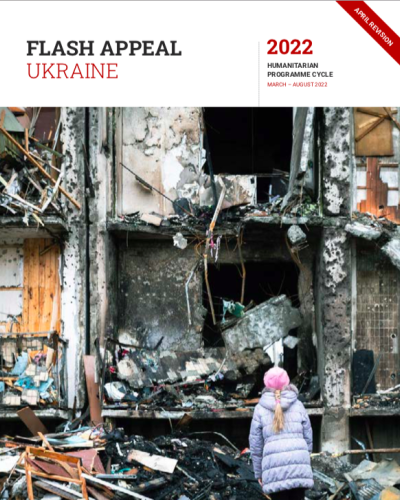Ukraine Flash Appeal (March-August 2022)

Two months on, needs have continued to rise, while the humanitarian response has expanded significantly in scale and scope—enabled by the rapid funding allocated against the initial Flash Appeal—prompting a revision and extension of the Ukraine Flash Appeal until August 2022.
Evolution of the crisis
The war in Ukraine, which began on 24 February, has caused death and suffering on a dramatic scale and left at least 15.7 million people in urgent need of humanitarian assistance and protection.
By 21 April, at least 2,345 civilians had been killed, including 177 children, according to the latest estimates by the UN High Commissioner for Human Rights.
However, the actual death toll is likely to be much higher. In Mariupol alone, local authorities estimate that tens of thousands of people have been killed, while the recent revelations of mass graves in Bucha, Irpin and other areas surrounding Kyiv highlight the likelihood of many more deaths that have not been counted. The war has seen the use of explosive weapons with a wide impact area in urban settings, including shelling from heavy artillery and multiple-launch rocket systems, and missile and air strikes. The presence of landmines and unexploded explosive ordnance is also a major concern. Even before this war, eastern Ukraine was one of the most mine-contaminated regions in the world.
The conflict has caused the world’s fastest growing displacement crisis since World War II, with nearly 13 million people uprooted in less than two months. Over a quarter of Ukraine’s population have fled their homes, including more than 7.7 million people now estimated to be internally displaced and over 5.2 million people who have crossed borders to seek security and safety in other countries, most of them women and children.
Nearly two-thirds of the children in Ukraine have been displaced.
Massive devastation in urban centres, and the destruction of civilian infrastructure, have made life unbearable for millions of people and severely disrupted critical services, especially healthcare. In besieged areas, people have lived for weeks without access to food, water and heat, while under the constant threat of bombardment. More than half of all attacks against healthcare facilities in the world this year—119 out of 182 by 11 April—have occurred in Ukraine. These attacks have decimated access to healthcare at a time when people need it most—women have been forced to deliver babies in basements, injured people have had no access to care and ill children have lost access to life-saving treatments.
Roughly 300 health facilities are in conflict areas and 1,000 health facilities are in areas that have changed control. Nearly 50 per cent of Ukraine’s pharmacies are presumed to be closed and many health workers are either displaced or unable to work. Other civilian infrastructure has also been severely impacted: more than 869 educational facilities have been damaged and 88 destroyed, according to the Ministry of Education, although these figures are not verified.
Millions of people—including women and small children—have been left without access to safe water or sanitation, drastically heightening the risk of waterborne disease as well as dehydration. Due to attacks on water system infrastructure and power outages an estimated 1.4 million people in eastern Ukraine do not have access to water, and another 4.6 million people across the country have only limited access.
Poor water quality can lead to diseases, including skin infections and scabies. People are having to live in crowded conditions and are unable to follow basic hygiene measures, including menstrual hygiene. This could lead to respiratory tract infections and the spread of COVID-19. Low and poor water supply can also cause outbreaks of communicable diseases, including cholera. The bacteria which causes cholera is present in the Mariupol area, as highlighted by the outbreak reported in the city 2011.
The war is impacting women and men in different ways and is exacerbating pre-existing inequalities, according to a Rapid Gender Analysis by UN Women and CARE. Ukraine’s population has a distinctly gendered profile, with 54 per cent women and 46 per cent men, including a particularly large population of older females. Prior to the escalation of the war, 71 per cent of the heads of households in Governmentcontrolled areas were female. Women from groups in vulnerable situations are being left behind and disproportionately affected by disruptions caused by war, while the displacement and refugee flow is largely gendered.
The threat of gender-based violence—including conflict-related sexual violence, sexual exploitation and abuse (SEA) and human trafficking—has risen exponentially since the war began. Two thirds of women in Ukraine had experienced some form of gender-based violence in their lifetime before the conflict and the deterioration of the security context has sharply increased the risk of multiple forms of violence.
There are mounting allegations of sexual violence perpetrated against women and girls during the war.
The armed conflict may prevent farmers from accessing their fields, harvesting, and marketing current crops, planting new crops, or sustaining livestock production. Between 20 and 30 per cent of areas under winter cereal, maize and sunflower production will remain unharvested in July/August, or not be planted this spring, according to the Government and FAO. About half of winter wheat and a third of rye due to be harvested in July–August 2022 are currently in war-affected areas. There are also concerns over damage to standing crops and risk of mines and unexploded ordnance impacting the ability to harvest in the period ahead.
The war has also devastated Ukraine’s economy. The Prime Minister of Ukraine, Denys Shmyhal, has said that economic losses due to the ongoing military offensive may exceed $1 trillion, while some 53 per cent of employed Ukrainians have lost their jobs since the war began, according to a nation-wide survey conducted by the Rating Group in March.




